Abstract
The liver plays a key role in the regulation of circulating levels of low density lipoproteins (LDL) because it is both the site for the production of and the major organ for the degradation of this class of lipoproteins. In this study, the effects of feeding polyunsaturated or saturated triacylglycerols on receptor-dependent and receptor-independent hepatic LDL uptake were measured in vivo in the hamster. In control animals, receptor-dependent LDL transport manifested an apparent Km value of 85 mg/dl (plasma LDL-cholesterol concentration) and reached a maximum transport velocity of 131 micrograms of LDL-cholesterol/hr per g, whereas receptor-independent uptake increased as a linear function of plasma LDL levels. Thus, at normal plasma LDL-cholesterol concentrations, the hepatic clearance rate of LDL equaled 120 and 9 microliter/hr per g by receptor-dependent and receptor-independent mechanisms, respectively. As the plasma LDL-cholesterol was increased, the receptor-dependent (but not the receptor-independent) component declined. When cholesterol (0.12%) alone or in combination with polyunsaturated triacylglycerols was fed for 30 days, receptor-dependent clearance was reduced to 36-42 microliter/hr per g, whereas feeding of cholesterol plus saturated triacylglycerols essentially abolished receptor-dependent LDL uptake (5 microliter/hr per g). When compared to the appropriate kinetic curves, these findings indicated that receptor-mediated LDL transport was suppressed approximately equal to 30% by cholesterol feeding alone and this was unaffected by the addition of polyunsaturated triacylglycerols to the diet. In contrast, receptor-dependent uptake was suppressed approximately equal to 90% by the intake of saturated triacylglycerols. As compared to polyunsaturated triacylglycerols, the intake of saturated lipids was also associated with significantly higher plasma LDL-cholesterol concentrations and lower levels of cholesteryl esters in the liver.
Full text
PDF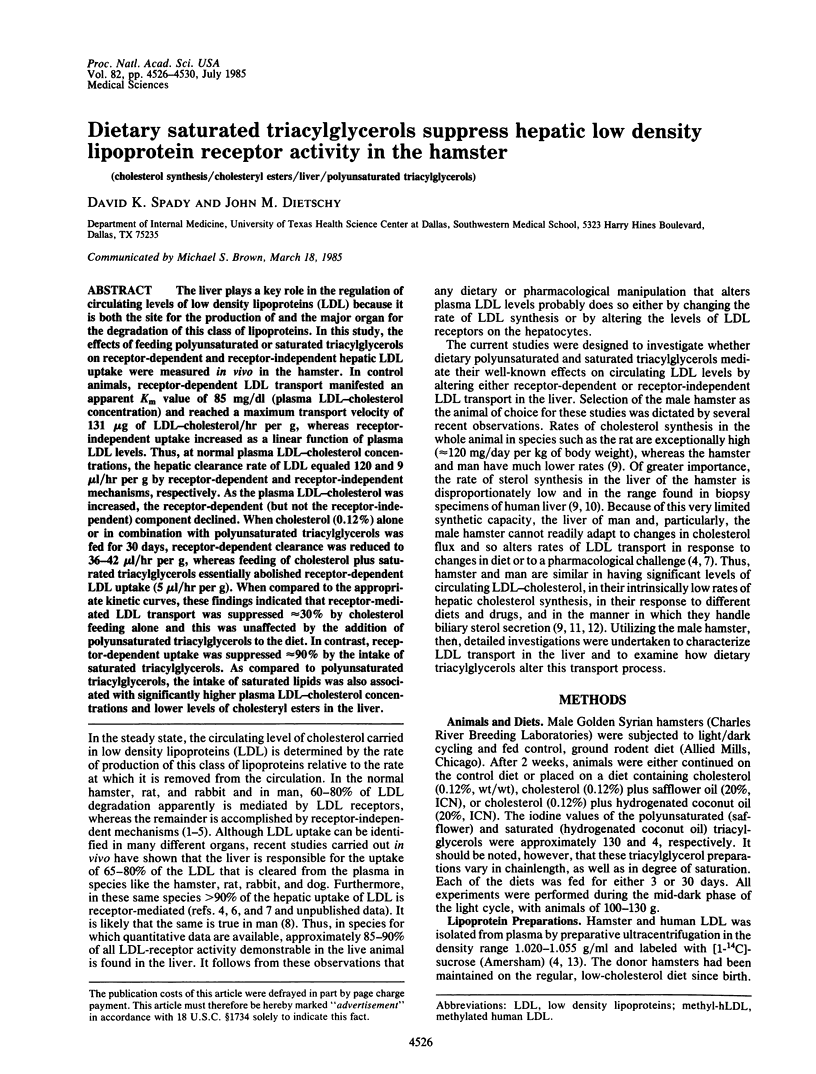
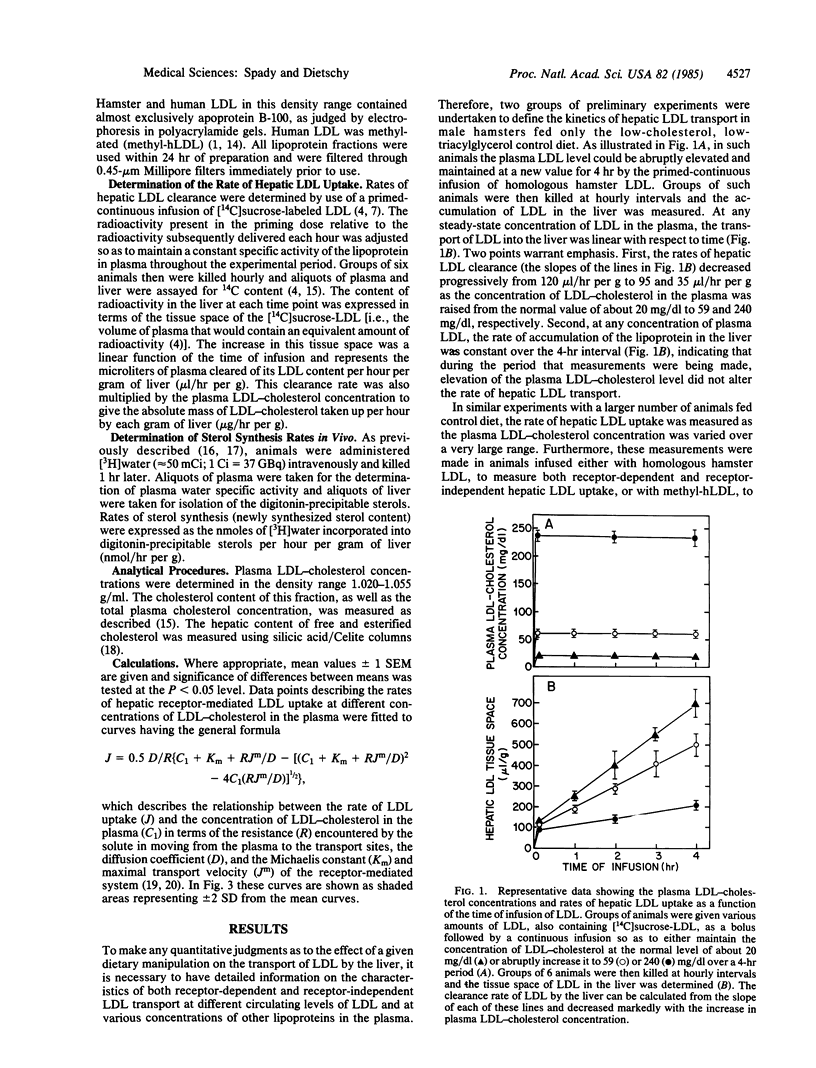
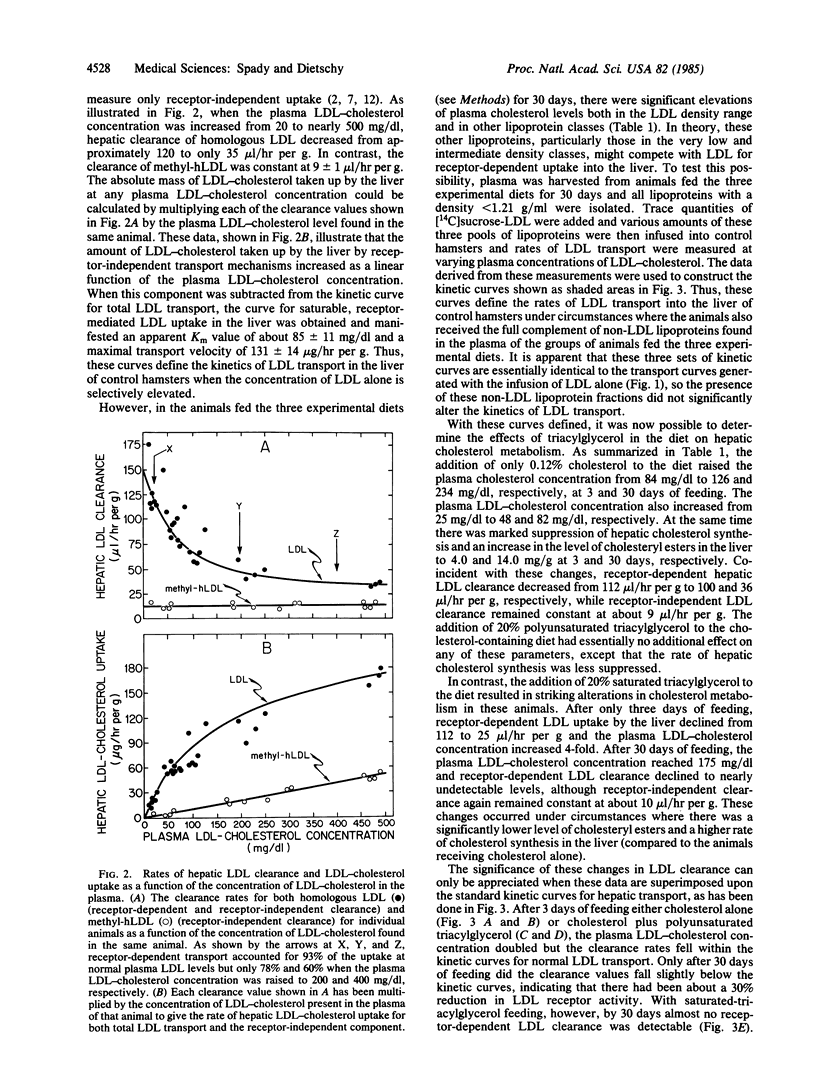
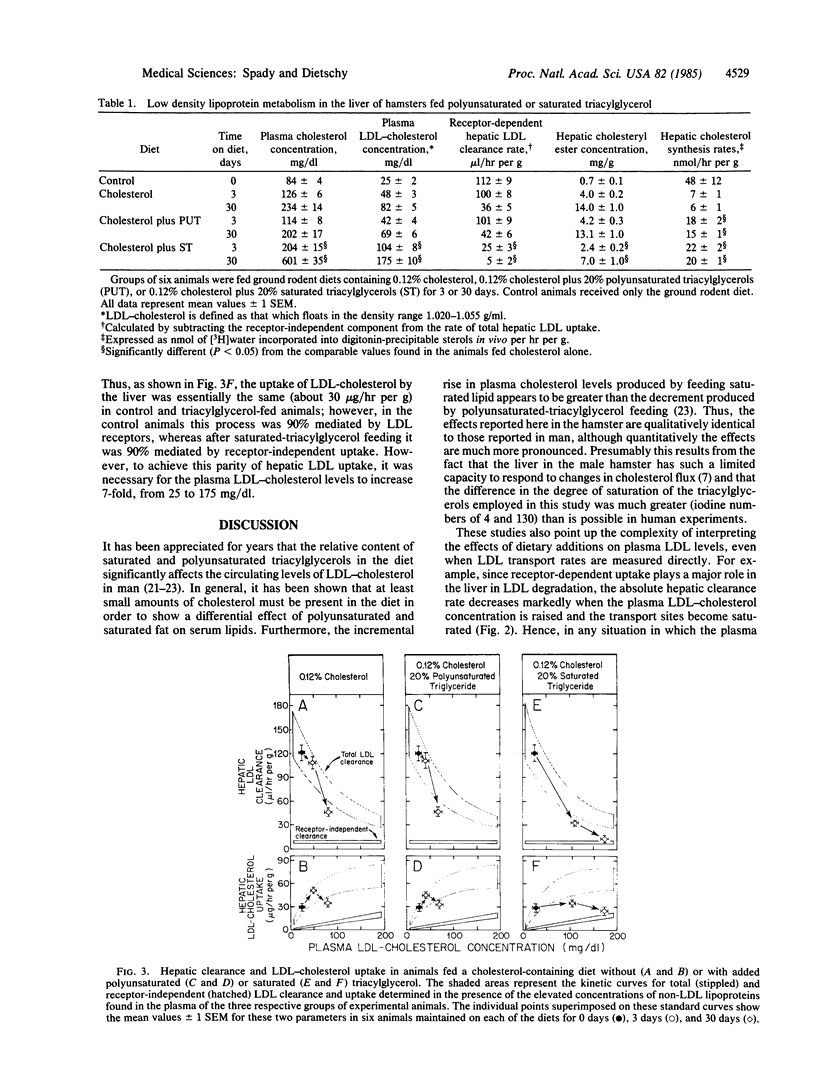
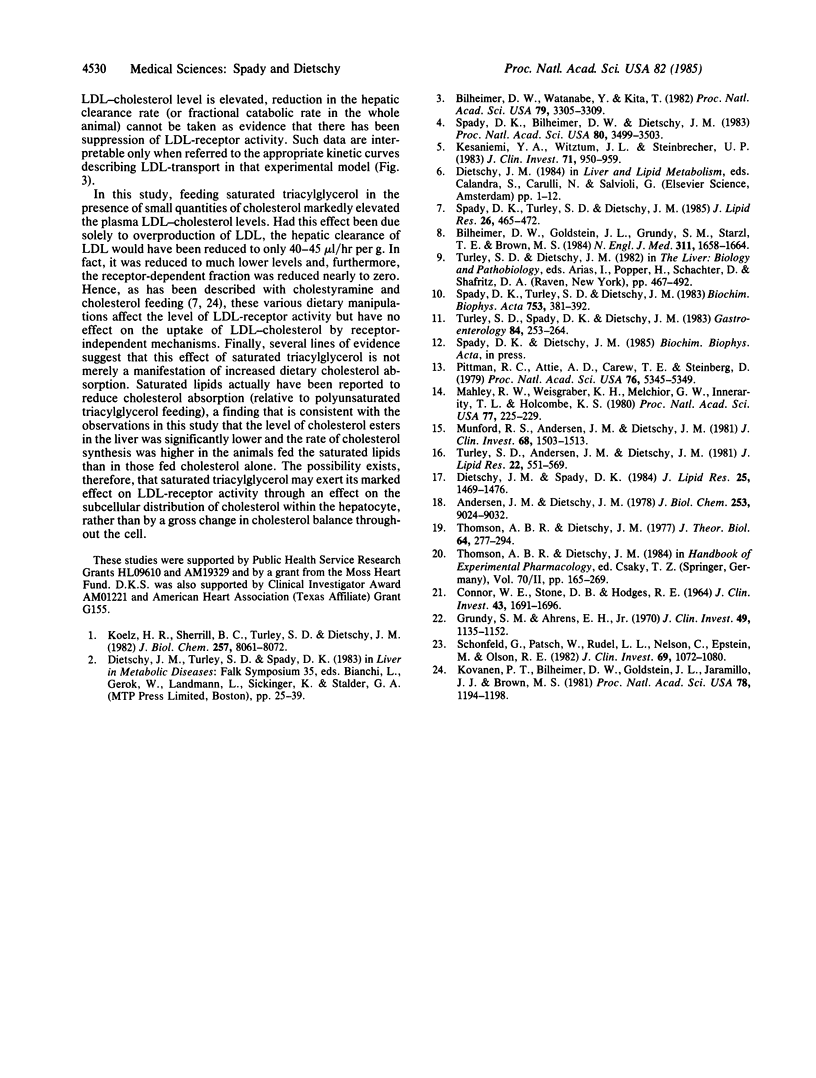
Images in this article
Selected References
These references are in PubMed. This may not be the complete list of references from this article.
- Andersen J. M., Dietschy J. M. Relative importance of high and low density lipoproteins in the regulation of cholesterol synthesis in the adrenal gland, ovary, and testis of the rat. J Biol Chem. 1978 Dec 25;253(24):9024–9032. [PubMed] [Google Scholar]
- Bilheimer D. W., Goldstein J. L., Grundy S. M., Starzl T. E., Brown M. S. Liver transplantation to provide low-density-lipoprotein receptors and lower plasma cholesterol in a child with homozygous familial hypercholesterolemia. N Engl J Med. 1984 Dec 27;311(26):1658–1664. doi: 10.1056/NEJM198412273112603. [DOI] [PMC free article] [PubMed] [Google Scholar]
- Bilheimer D. W., Watanabe Y., Kita T. Impaired receptor-mediated catabolism of low density lipoprotein in the WHHL rabbit, an animal model of familial hypercholesterolemia. Proc Natl Acad Sci U S A. 1982 May;79(10):3305–3309. doi: 10.1073/pnas.79.10.3305. [DOI] [PMC free article] [PubMed] [Google Scholar]
- CONNOR W. E., STONE D. B., HODGES R. E. THE INTERRELATED EFFECTS OF DIETARY CHOLESTEROL AND FAT UPON HUMAN SERUM LIPID LEVELS. J Clin Invest. 1964 Aug;43:1691–1696. doi: 10.1172/JCI105044. [DOI] [PMC free article] [PubMed] [Google Scholar]
- Dietschy J. M., Spady D. K. Measurement of rates of cholesterol synthesis using tritiated water. J Lipid Res. 1984 Dec 15;25(13):1469–1476. [PubMed] [Google Scholar]
- Grundy S. M., Ahrens E. H., Jr The effects of unsaturated dietary fats on absorption, excretion, synthesis, and distribution of cholesterol in man. J Clin Invest. 1970 Jun;49(6):1135–1152. doi: 10.1172/JCI106329. [DOI] [PMC free article] [PubMed] [Google Scholar]
- Kesaniemi Y. A., Witztum J. L., Steinbrecher U. P. Receptor-mediated catabolism of low density lipoprotein in man. Quantitation using glucosylated low density lipoprotein. J Clin Invest. 1983 Apr;71(4):950–959. doi: 10.1172/JCI110849. [DOI] [PMC free article] [PubMed] [Google Scholar]
- Koelz H. R., Sherrill B. C., Turley S. D., Dietschy J. M. Correlation of low and high density lipoprotein binding in vivo with rates of lipoprotein degradation in the rat. A comparison of lipoproteins of rat and human origin. J Biol Chem. 1982 Jul 25;257(14):8061–8072. [PubMed] [Google Scholar]
- Kovanen P. T., Bilheimer D. W., Goldstein J. L., Jaramillo J. J., Brown M. S. Regulatory role for hepatic low density lipoprotein receptors in vivo in the dog. Proc Natl Acad Sci U S A. 1981 Feb;78(2):1194–1198. doi: 10.1073/pnas.78.2.1194. [DOI] [PMC free article] [PubMed] [Google Scholar]
- Mahley R. W., Weisgraber K. H., Melchior G. W., Innerarity T. L., Holcombe K. S. Inhibition of receptor-mediated clearance of lysine and arginine-modified lipoproteins from the plasma of rats and monkeys. Proc Natl Acad Sci U S A. 1980 Jan;77(1):225–229. doi: 10.1073/pnas.77.1.225. [DOI] [PMC free article] [PubMed] [Google Scholar]
- Munford R. S., Andersen J. M., Dietschy J. M. Sites of tissue binding and uptake in vivo of bacterial lipopolysaccharide-high density lipoprotein complexes: studies in the rat and squirrel monkey. J Clin Invest. 1981 Dec;68(6):1503–1513. doi: 10.1172/JCI110404. [DOI] [PMC free article] [PubMed] [Google Scholar]
- Pittman R. C., Attie A. D., Carew T. E., Steinberg D. Tissue sites of degradation of low density lipoprotein: application of a method for determining the fate of plasma proteins. Proc Natl Acad Sci U S A. 1979 Oct;76(10):5345–5349. doi: 10.1073/pnas.76.10.5345. [DOI] [PMC free article] [PubMed] [Google Scholar]
- Schonfeld G., Patsch W., Rudel L. L., Nelson C., Epstein M., Olson R. E. Effects of dietary cholesterol and fatty acids on plasma lipoproteins. J Clin Invest. 1982 May;69(5):1072–1080. doi: 10.1172/JCI110542. [DOI] [PMC free article] [PubMed] [Google Scholar]
- Spady D. K., Bilheimer D. W., Dietschy J. M. Rates of receptor-dependent and -independent low density lipoprotein uptake in the hamster. Proc Natl Acad Sci U S A. 1983 Jun;80(11):3499–3503. doi: 10.1073/pnas.80.11.3499. [DOI] [PMC free article] [PubMed] [Google Scholar]
- Spady D. K., Turley S. D., Dietschy J. M. Dissociation of hepatic cholesterol synthesis from hepatic low-density lipoprotein uptake and biliary cholesterol saturation in female and male hamsters of different ages. Biochim Biophys Acta. 1983 Oct 11;753(3):381–392. doi: 10.1016/0005-2760(83)90062-0. [DOI] [PubMed] [Google Scholar]
- Spady D. K., Turley S. D., Dietschy J. M. Rates of low density lipoprotein uptake and cholesterol synthesis are regulated independently in the liver. J Lipid Res. 1985 Apr;26(4):465–472. [PubMed] [Google Scholar]
- Thomson A. B., Dietschy J. M. Derivation of the equations that describe the effects of unstirred water layers on the kinetic parameters of active transport processes in the intestine. J Theor Biol. 1977 Jan 21;64(2):277–294. doi: 10.1016/0022-5193(77)90357-5. [DOI] [PubMed] [Google Scholar]
- Turley S. D., Andersen J. M., Dietschy J. M. Rates of sterol synthesis and uptake in the major organs of the rat in vivo. J Lipid Res. 1981 May;22(4):551–569. [PubMed] [Google Scholar]
- Turley S. D., Spady D. K., Dietschy J. M. Alteration of the degree of biliary cholesterol saturation in the hamster and rat by manipulation of the pools of preformed and newly synthesized cholesterol. Gastroenterology. 1983 Feb;84(2):253–264. [PubMed] [Google Scholar]



